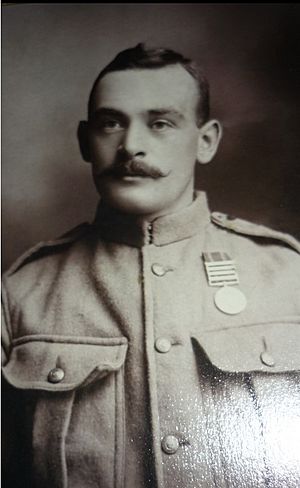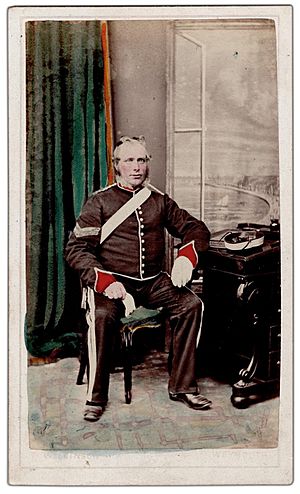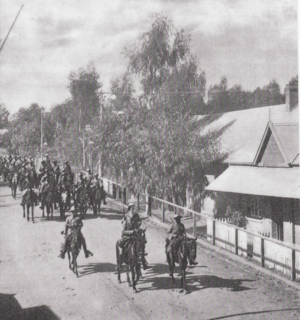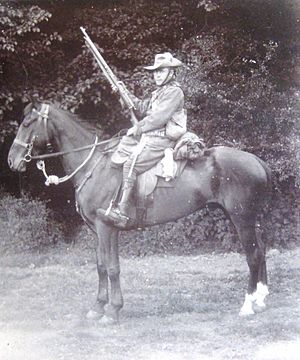Queen's Own Dorset Yeomanry facts for kids
Quick facts for kids Queen's Own Dorset Yeomanry |
|
|---|---|

Cap badge of the Queen's Own Dorset Yeomanry (c. 1914)
|
|
| Active | 1794 – 1802 1803 – 1814 1830 – 1967 1997 – present |
| Country | |
| Branch | |
| Role | Yeomanry (Second Boer War) Yeomanry (First World War) Artillery (Second World War) |
| Size | One Company (Second Boer War) Three Regiments (First World War) Two Regiments (Second World War) One Squadron (Current) |
| Engagements | Second Boer War First World War Second World War See battle honours below |
| Commanders | |
| Colonel of the Regiment |
Lieutenant General Arundell D. Leakey, CMG, CVO, CBE |
The Queen's Own Dorset Yeomanry was a special kind of army unit in the British Army. It started way back in 1794. Back then, it was called the Dorsetshire Regiment of Volunteer Yeomanry Cavalry. It was created because people were worried about an invasion during the Napoleonic wars.
This unit got its first royal connection in 1833. It was named after Princess Victoria. Later, in 1843, it became the Queen's Own Regiment of Dorset Yeomanry Cavalry.
Contents
History of the Dorset Yeomanry
How it Started and Early Days
In 1793, the British government was worried about an attack from the French Revolutionary government. They didn't have enough soldiers to defend the country. So, in 1794, the government decided to create more local defence groups. These groups were called "Gentlemen and Yeomanry Cavalry." They were made up of volunteers who rode horses.
The Dorset Yeomanry first formed on May 9, 1794. It had six small groups called troops. By 1796, it grew to ten troops and was called the Dorsetshire Rangers. But in 1802, a peace treaty was signed, and the unit was disbanded.
When the peace ended in 1803, the regiment was started again. It had seven troops this time. In 1814, it was disbanded once more.
The unit came back in 1830, and this time it lasted much longer. It was reformed from troops in places like Wimborne and Blandford. In 1833, it got royal support and was named after Princess Victoria. In 1843, it became the Queen's Own Regiment of Dorset Yeomanry Cavalry. Its main office was in Dorchester.
In 1893, the troops were reorganized into larger groups called squadrons. The main office moved to Weymouth.
Fighting in the Second Boer War
In 1899, the British government decided to let volunteer soldiers fight in the Second Boer War in South Africa. After some tough losses, they needed more troops. So, they created the Imperial Yeomanry. This new group asked existing Yeomanry regiments to send companies of about 115 men. Many British volunteers also joined.
The first group of Imperial Yeomanry arrived in South Africa in early 1900. The Queen's Own Dorset Yeomanry sent soldiers for the 26th Company. They fought in many important battles. These included the Relief of Wepener, the Battle of Doornkop, and the Capture of Pretoria. They also took part in many smaller fights.

In 1901, the regiment changed its name to the Dorsetshire Imperial Yeomanry (Queen's Own). It was reorganized into four squadrons and a machine gun section. In 1902, its main office moved to Sherborne. In 1908, it became the Dorset Yeomanry (Queen's Own) for the last time. It joined the Territorial Force, which was a home defence army. The unit was trained like hussars, who were light cavalry soldiers.
Here's how the regiment was set up:
| Dorset Yeomanry (Queen's Own) | |
|---|---|
| Headquarters | Sherborne |
| A Squadron | Dorchester |
| B Squadron | Sherborne |
| C Squadron | Blandford |
| D Squadron | Gillingham |
The First World War
When the First World War started in 1914, many soldiers in the Territorial Force volunteered to serve overseas. So, the units were split into three groups:
- 1st Line: These soldiers could go fight overseas.
- 2nd Line: These soldiers stayed home to defend the country.
- 3rd Line: This group trained new soldiers to replace those fighting.
1st Line: 1/1st Queen's Own Dorset Yeomanry
The 1st Line regiment was ready for war in August 1914. It was sent to Egypt in 1915. From there, it went to the Dardanelles campaign. The soldiers fought on foot in the Battle of Gallipoli.
After leaving Gallipoli, they returned to Egypt in 1916. They became part of the 6th Mounted Brigade. This brigade fought in the action of Agagia in February 1916. In this battle, the Dorset Yeomanry charged the enemy on horseback. They lost many horses and soldiers, but they captured the Turkish leader, Jaffir Pasha.
Later, they joined the Imperial Mounted Division. They fought in the First and Second Battles of Gaza. They also took part in the Third Battle of Gaza and the Battle of Beersheba. They stayed in Palestine until the war ended.
2nd Line: 2/1st Queen's Own Dorset Yeomanry
The 2nd Line regiment formed in Sherborne in September 1914. They moved around the UK. In 1916, many Yeomanry units were changed into cyclist units. So, the regiment stopped using horses and became cyclists.
Later, in November 1916, they got their horses back. They joined the 3rd Mounted Brigade. But in September 1917, they became cyclists again! They moved to Ireland in 1918 and stayed there until the end of the war.
3rd Line: 3/1st Queen's Own Dorset Yeomanry
The 3rd Line regiment formed in 1915. Their job was to train new soldiers. They were based at Tidworth and later at The Curragh. In 1917, they joined a larger training unit.
Between the World Wars
After the First World War, in 1920, the regiment became part of the Territorial Army again. It was decided that only a few Yeomanry regiments would stay as horse cavalry. The others would change roles. So, in 1922, the Dorset Yeomanry became an artillery unit. This meant they would use cannons instead of horses.
They formed two batteries (groups of cannons). These batteries joined another unit to become the 94th (Dorset and Somerset Yeomanry) Brigade, RFA. Later, in 1929, the Somerset batteries moved, and the Dorset Yeomanry became the 94th (Queen's Own Dorset Yeomanry) Army Field Brigade, RA. Its main office moved back to Dorchester.
In 1938, these artillery groups became regiments. So, it was renamed the 94th (Queen's Own Dorset Yeomanry) Field Regiment, RA. In 1939, the Territorial Army "duplicated" its units. This meant existing units formed a second unit. So, some of the batteries from the 94th formed the new 141st Field Regiment, RA.
The Second World War
During the Second World War, artillery regiments were changed to have three batteries instead of two. This made them better at supporting infantry (foot soldiers).
94th (Queen's Own Dorset Yeomanry) Field Regiment, RA
The 94th Field Regiment stayed in the UK for most of the war. In June 1944, it went to France to fight in the North West Europe Campaign. It stayed with the 43rd (Wessex) Infantry Division until the war ended.
141st (Queen's Own Dorset Yeomanry) Field Regiment, RA
The 141st Field Regiment also stayed in the UK throughout the war. It was authorized to use the "Queen's Own Dorset Yeomanry" name from February 1942. It moved between different army divisions during the war, including the 9th Armoured Division and the 55th Infantry Division.
After the Wars
In 1947, the regiment was reformed in the Territorial Army. It became two separate artillery regiments: the 294th Field Regiment RA and the 341st Medium Regiment RA. In 1950, these two joined together to form the 294th.
In 1961, the regiment merged again with another unit, forming the 250th (Queen's Own Dorset and West Somerset Yeomanry) Medium Regiment RA. But in February 1967, this new regiment was disbanded. Some of its soldiers went on to form two infantry companies.
The Dorset Yeomanry Today
In 1997, a new unit called 'The Dorset Yeomanry' was formed. This new regiment didn't carry on the exact history or battle honours of the old Queen's Own Dorset Yeomanry. In 1999, it became a single squadron (a smaller unit) called "A" (Dorset Yeomanry) Squadron. It is now part of the Royal Wessex Yeomanry.
The Royal Wessex Yeomanry has a few roles:
- Some squadrons train soldiers to be crew members for Challenger 2 tanks.
- The main headquarters and the "A" (Dorset Yeomanry) Squadron help develop new ideas for tank replacement and support other army groups.
Battle Honours
Battle honours are special awards given to military units for their bravery and success in battles. The Queen's Own Dorset Yeomanry earned many of these honours. The ones in bold are proudly displayed on their regimental flags.
| Second Boer War | South Africa 1900–01 |
| First World War | Suvla, Scimitar Hill, Gallipoli 1915, Agagiya, Egypt 1915–17, Gaza, El Mughar, Nebi Samwil, Megiddo, Sharon, Damascus, Palestine 1917–18 |
| Second World War | The Royal Artillery was in almost all battles. In 1833, King William IV gave them the motto Ubique (meaning "everywhere") instead of listing all battle honours. |
Uniforms Over Time
The uniforms of the Dorset Yeomanry changed a lot over the years.
- From 1830 to 1847, they wore a tall hat called a shako with a red jacket and blue trimmings.
- After 1850, they started wearing a dark blue tunic.
- In 1883, they adopted a hussar style uniform. This included white braided loops and a tall, furry hat called a busby.
- After the Boer War, they switched to a practical khaki uniform with green parts. They wore a slouch hat with this.
- By 1908, officers wore the fancy dark blue hussar uniform again for special events.
- Later, they mostly wore the standard khaki service and battle uniforms of the British Army.
See also
- Imperial Yeomanry
- List of Yeomanry Regiments 1908
- Yeomanry
- Yeomanry order of precedence
- British yeomanry during the First World War
- Second line yeomanry regiments of the British Army
- List of British Army Yeomanry Regiments converted to Royal Artillery




